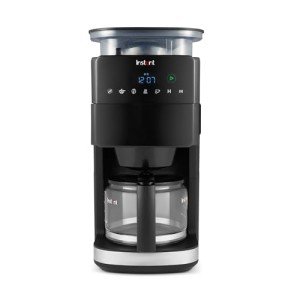17 Signs That You Work With Whole Bean Coffee Machine
The Ultimate Guide to Whole Bean Coffee Machines
In an age where coffee lovers have become increasingly discerning, the choice of a coffee machine has become more critical than ever. Whole bean coffee machines have actually emerged as a favorite among serious coffee drinkers, permitting them to draw out the best flavors from coffee beans. This post explores the intricacies of whole bean coffee machines, exploring their features, advantages, and factors to consider for the passionate coffee fan.
What is a Whole Bean Coffee Machine?
A whole bean coffee machine is created to grind coffee beans just before brewing, making sure optimum freshness and flavor extraction. Unlike conventional coffee machine that rely on pre-ground coffee, these machines integrate a mill, which enables the user to choose the grind size matched to their brewing technique, from espresso to French press.
Advantages of Whole Bean Coffee Machines
Freshness: The main advantage of using whole beans is that they keep their flavor longer than pre-ground coffee. Grinding prior to developing preserves the fragrant oils that add to the overall flavor profile.
Personalization: Many whole bean machines allow users to adjust grind settings, water temperature, and brewing time to develop a personalized cup of coffee that satisfies private preferences.
Quality Control: Whole bean coffee machines empower users to pick premium beans from various sources, making it easier to explore distinct flavor profiles.
Flexibility: These machines deal with different brewing approaches, allowing users to craft espresso, drip coffee, or specialty brews with ease.
Convenience: Integrated grinders streamline the coffee-making procedure, reducing the need for additional equipment and decreasing clean-up.
Secret Features to Consider
When choosing a whole bean coffee machine, a number of features must be thought about:
Grinder Type:
- Burr vs. Blade: Burr mills offer a more uniform grind, which is crucial for consistency in taste, whereas blade mills tend to produce irregular grinds.
Brew Method Compatibility: Ensure the machine can accommodate the developing approach preferred (e.g., espresso, pour-over, French press).
Capacity: Consider the hopper size for holding coffee beans; bigger capabilities indicate less frequent refilling.
User Interface: Look for machines with user-friendly controls, permitting users of all skill levels to operate them quickly.
Maintenance: Machines that are easy to clean and preserve will save time and ensure the durability of the gadget.
Product Quality: Stainless steel and state-of-the-art plastic offer sturdiness, while machines with glass elements tend to be less durable.
Popular Whole Bean Coffee Machines
Brand
Model
Mill Type
Capacity (Cups)
Features
Rate Range (₤)
Breville
BES870XL Barista Express
Burr
8
Espresso machine, steam wand
600 – 700
De'Longhi
EC702
Pump
10
Dual boiler system, stainless-steel
300 – 400
Cuisinart
DCC-3200P1
Blade
14
24-hour programmable, drip coffee
50 – 100
Rancilio
Silvia
Burr
2
Expert feel, steam power
700 – 800
Hamilton Beach
49980A
Mixed
2
Single-serve, versatile brewing
30 – 50
How to Make one of the most Out of Your Whole Bean Coffee Machine
To accomplish the best results with a whole bean coffee machine, consider the following pointers:
Quality Beans: Always select high-quality, fresh beans that match your taste.
Grind Size: Adjust the grind size based on the brewing approach. Finer grinds are appropriate for espresso, while coarser grinds work much better for French press.
Brewing Temperature: Water temperature ought to typically be between 195 ° F and 205 ° F (90 ° C -96 ° C) for optimum extraction.
Water Quality: Use filtered water for the best taste and to prolong the machine's life expectancy.
Maintenance Schedule: Regularly clean the mill and machine to prevent residue buildup and ensure consistent performance.
Frequently Asked Questions about Whole Bean Coffee Machines
1. Is a whole bean coffee machine worth the financial investment?
Yes, if you value the freshness and taste of your coffee, buying a whole bean coffee machine is advantageous. It permits for a richer and more fragrant cup of coffee compared to pre-ground choices.
2. How do I tidy my whole bean coffee machine?
Many machines come with cleaning directions. Usually, you'll need to eliminate the mill, tidy the hopper, and run a cleansing cycle with water. Usage brushes specifically designed for this purpose.
3. Can Best Bean To Cup Machines utilize pre-ground coffee in a whole bean machine?
Many whole bean coffee machines are particularly created for whole beans; nevertheless, some might enable you to use pre-ground coffee. Seek advice from the manufacturer's standards.
4. What is the best grind size for espresso?
A great grind is typically preferred for espresso. However, experimentation can help find the ideal grind size that matches your taste choices.
5. How typically should I replace the coffee beans?
For optimal freshness, it is encouraged to utilize coffee beans within two weeks of opening after they have been roasted. Store them in an airtight container away from light and wetness.
A whole bean coffee machine can elevate the coffee experience, offering freshness, modification, and remarkable flavor. With many choices available, possible purchasers can find a machine that fits their way of life and coffee preferences. By considering the aforementioned functions, pointers for optimization, and preserving a consistent cleansing regimen, users can savor every cup of newly brewed, fragrant coffee for many years to come. Whether for personal use or entertaining visitors, purchasing a whole bean coffee machine is an action towards coffee perfection.
